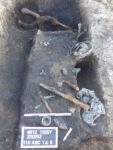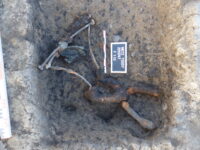 The charred remains of a curule chair have been recovered from a 1st century A.D. funeral pyre in the town of Épagny-Metz-Tessy in southeastern France. Archaeologists discovered the remains of two Roman funeral pyres in a salvage excavation before construction of new residential buildings.
The charred remains of a curule chair have been recovered from a 1st century A.D. funeral pyre in the town of Épagny-Metz-Tessy in southeastern France. Archaeologists discovered the remains of two Roman funeral pyres in a salvage excavation before construction of new residential buildings.
The first pyre is the oldest of the two. It contains the remains of a young child between five and eight years old at time of death. The pyre was furnished with a great abundance of goods, including 17 ceramic vessels, 10 bronze vases and four glass vessels containing the remains of food offerings (lentils, beans, pork, rooster, wine). It was the child’s final banquet, and it was a grand one. Other goods were use items — three copper alloy strigils, bone game tokens — and furnishings (the funeral bed, boxes).
 The second pyre was far more elaborate. The deceased was an adult of relatively advanced age, and clearly someone of immense wealth and rank. His grave contained 20 ceramic vases, at least 20 glass containers, 46 bronze utensils and kitchenware containing the remains of wine, lentils, beans, beef, pork, hare, rooster, partridge, duck and fish. There were strigils in this grave too, silver ones, plus a pair of gold earrings and a fragment of a textile embroidered with gold thread.
The second pyre was far more elaborate. The deceased was an adult of relatively advanced age, and clearly someone of immense wealth and rank. His grave contained 20 ceramic vases, at least 20 glass containers, 46 bronze utensils and kitchenware containing the remains of wine, lentils, beans, beef, pork, hare, rooster, partridge, duck and fish. There were strigils in this grave too, silver ones, plus a pair of gold earrings and a fragment of a textile embroidered with gold thread.
Amidst all these fine treasures, one object stands out for its symbolism and rarity: an iron curule chair with bronze decorations.
The X-shaped seat is composed of two iron frames with “S” uprights, articulated and intended to work with a set of leather or fabric straps stretched to allow seating. The feet are flat circular shapes and arranged perpendicular to the uprights which themselves have a rectangular section. The two sets of crossbars have round sections. The heads of the uprights are divided into two lateral tabs forming a semicircle framing a rod of round section; a washer is affixed halfway up the rod. The end of the latter is put down to fix everything.
The curule chair is one of the major symbols of power in Rome. Of Etruscan tradition, its use is reserved in Rome, initially, to the high magistrates (consuls, praetors) holders of the imperium, that is to say the power to order and to punish. Under Augustus, it is one of the attributes of the emperor. Two types of seat are referenced. On the one hand, the sella curulis strictly speaking, recognizable by its “S” shaped legs: initially reserved for the civil magistracy, it became a luxury household item reserved for an elite from the 1st century AD. On the other hand, the sella castrensis with its “X” profile which is the prerogative of military officers.
Curule chairs are found carved on funerary stele where they symbolize the deceased’s important civic role, but the chairs themselves are vanishingly rare finds in funerary contexts or any other, for that matter. A grand total of eight folding x-shaped chairs have been found in Roman burials France, and this latest discovery is only the fourth full-featured sella curulis.
Of the eight examples listed in France, seven are cremations. This practice makes it almost impossible to determine the sex of the deceased. As for the only burial, it is attributed to a woman.
Thus, if the presence of the seat would be statistically more in favor of a male subject, the hypothesis of a deceased cannot be ruled out and the presence of the earrings would moreover plead more in favor of this possibility.